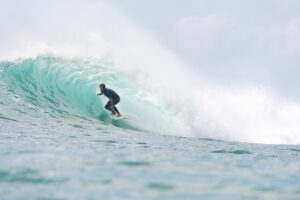
Famara Beach is one of the favorite destinations for surf enthusiasts all across Europe, and it’s not without reason. Why? Caleta de Famara, with its 6 kilometers of golden sand, magical sunsets, a passionate community of surfers, and its status as a natural park, creates a paradise-like atmosphere that is hard to beat. But that’s not all. This oval-shaped beach offers a variety of wave types suitable for all levels of surfing. Below, we present a guide to the available surf peaks, wave types, and their difficulty levels so you can better navigate and enjoy Famara Beach and its waves.
Papelillo: Located at the end of the road, on the right side of the beach, at the foot of Mount Risco, Papelillo is a wave that particularly shines with low to mid tide. It receives swells from the west, northwest, and north and is characterized by being a fun and tubular wave, often offering both right and left tubes. The tranquility and wonderful views complement the experience. The seabed is sandy.
Las Bajas: Las Bajas are waves for brave surfers. They break far out at sea, being large, powerful, and tubular. They are ideal for tow-in and big boards, working well with both high and low tide and swells from the west, northwest, and north. However, caution is advised, and it’s recommended not to surf alone, as the bottom is rocky.
El Palo: El Palo is the star peak of Famara Beach, always standing out for its size, openness, and orderly waves. It offers both rights and lefts, accommodating surfers of all levels. Here, you can enjoy various sessions, from tubes to maneuvers. There is plenty of space and few people, creating a friendly surfing atmosphere. On windy days, it’s also a perfect spot for kite surfing.
Búnker: Búnker is known for its consistency, with both right and left waves flowing with organized peaks and currents. It’s an ideal spot for beginners, calm and family-friendly, with parking near Lanzasurf in the Bungalos area. The seabed is sandy, and generally, two breaks are formed. This is where we offer our surf lessons, suitable for surfers of all levels.
Socorristas: Socorristas is an excellent choice, with both right and left waves that attract many surfers. The current in this area leads toward the peak, making the return easier. The right is fast and long, providing an exciting experience but more suitable for advanced surfers due to the current.
El Molino: Located between the village and the lifeguard area, El Molino is a good option for beginners. The waves here tend to be smaller than at other peaks, making it a busy place and suitable for novice surfers. However, it’s important to consider side currents and the possibility of rocky areas.
Codito: Located near the village, to the left of the beach, Codito offers smaller waves compared to other peaks. The seabed combines rock and sand, and it’s recommended to surf at mid-tide instead of low tide. It’s an easy entry spot and is primarily recommended for intermediate or advanced surfers.
Barco or Sabía: This offshore break offers long and smooth waves, perfect for longboard lovers. You’ll need to wait for north swells and prefer low tide to make the most of this experience. Tip: Always check the conditions before heading into the water.





